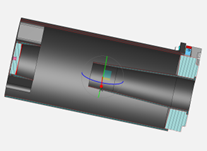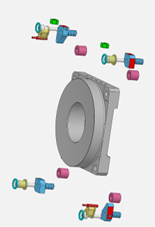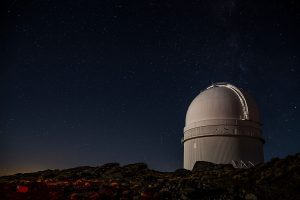Key Takeaways
- Design optimizations enhanced telescope manufacturability and performance.
- Replacing the optical tube with carbon fiber reduced weight and improved thermal stability.
- A redesigned secondary mirror mount with locating pins and adhesive injection holes ensured precise, long-term alignment.
- Adding shims and positioning pins between the primary mirror and tube enabled fine-tuned alignment and post-assembly stability.
- These changes delivered a lightweight, stable, and high-performance system meeting λ/4 wavefront error and >90% transmittance specifications.
Project Background
A high-performance optical telescope system was under development for aerospace imaging applications, requiring not only precision optical alignment but also robust manufacturability. Initial designs raised concerns related to weight, alignment stability, and assembly complexity, especially in demanding environments. A series of design optimizations were undertaken to address these challenges while preserving optical performance.
Objectives
- Reduce system weight without compromising structural stability
- Improve ease of assembly and alignment
- Ensure long-term positional stability of optical elements
- Maintain high optical performance:
- Surface Quality: 60-40 Scratch-Dig
- Transmitted Wavefront Error: λ/4
- Transmittance: T(peak) S&P > 95%, Tavg > 90%
- Surface Quality: 60-40 Scratch-Dig
Optimization 1: Carbon Fiber Optical Tube Replacement
Before:
The optical tube was originally constructed using aluminum alloy, which provided strength but added unnecessary weight and was prone to thermal expansion.
Solution:
The optical tube material was replaced with carbon fiber composite, which offers:
- Lightweight properties (reducing total mass for space payload requirements)
- High modulus and thermal stability (critical for preserving alignment under varying temperatures)
- Ease of manufacturing using filament winding and layup techniques
- Proven aerospace reliability
Impact:
The carbon fiber tube significantly reduced system weight and thermal drift, improving both launch survivability and in-orbit optical stability.
Optimization 2: Secondary Mirror Mounting Redesign
Before:
The secondary mirror mounting lacked defined reference points, resulting in difficulties during assembly and potential long-term misalignment under vibration or thermal cycling.
Solution:
The design was enhanced by incorporating:
- Precision locating pins for accurate mirror placement
- Adhesive injection holes to secure bonding without introducing stress or voids
Impact:
The new mounting configuration allowed for repeatable positioning with enhanced structural integrity, maintaining optical alignment over time and across varying operating conditions.
Optimization 3: Primary Mirror Alignment Enhancement
Before:
The interface between the primary mirror and the tube relied solely on fixed contact points, limiting adjustability during assembly.
Solution:
- Adjustment shims were added to allow micro-adjustments during alignment
- Positioning pins were included to lock in alignment post-calibration


Impact:
This change enabled precise axial and angular alignment between the primary and secondary mirrors during assembly, ensuring optimal system performance while minimizing rework or field adjustment.
Conclusion
Through targeted mechanical redesign—specifically in material selection, optical component mounting, and alignment methodology—the team achieved a more robust, lightweight, and manufacturable telescope system. The result met all optical specifications and exceeded structural and thermal performance expectations for aerospace deployment.
Related Content
GREAT ARTICLE!
Share this article to gain insights from your connections!





